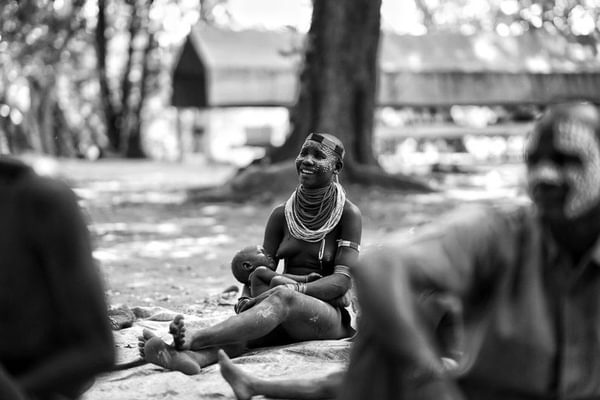Speak to a Ethiopia expert today
and start planning your tailor-made holiday

Alistair


Can't decide where to go? Why not peruse some of our most popular destinations for inspiration then give us a call!

A diverse land brimming with superb safaris, pristine sandy beaches, towering snow-capped peaks and tropical underwater worlds is just waiting to welcome you

Australia offers vibrant cities, diverse landscapes, and iconic wonders like the Great Barrier Reef. New Zealand adds dramatic scenery, Maori culture, and relaxed charm. Together, they promise nature, adventure, culture, and warm hospitality.

If you're dreaming of an island getaway, look no further than the Caribbean with its gorgeous soft sand beaches and lively, diverse cultures.

Head to the amazing destination that is Central America, full of the knowledge of ancient civilizations, incredible mountains, and beautiful beaches.

Discover vibrant cultures, pristine beaches, and tantalizing flavours in the captivating travel haven that is East and Southeast Asia

Embark on a journey through the vibrant tapestry of India, Sri Lanka, and Bhutan—where ancient temples, lush tea plantations, and soaring Himalayan peaks promise unforgettable moments at every turn.

Picture yourself basking on sun-kissed beaches, sipping tropical cocktails beneath swaying palms —where crystal-clear lagoons and luxurious resorts cater to your every desire.

Experience world-class hospitality, mouthwatering cuisines, and the region’s deep-rooted cultural traditions for an unforgettable Middle East adventure.

Venture to the ends of the Earth and behold the icy majesty of polar landscapes. Discover pristine solitude, exhilarating expeditions, and breathtaking views that promise a memorable encounter with nature at its most dramatic

Journey into the heart of South America, where the rhythmic pulse of its vibrant cities meets the majesty of the Amazon rainforest and the timeless wonder of ancient civilizations.

The South Pacific is a paradise of turquoise waters, white-sand beaches, and vibrant island cultures. From adventure and natural beauty to pure relaxation, each island offers its own unique charm and welcome.

From the soaring plains of the Southwestern USA to the stunning landscapes of the expanses of Canada, visit some of the most impressive scenery in the world

If you are looking for a trip to knock iconic locations off your bucket list, check out our buck list recommendations

From the graceful stride of giraffes at sunrise to the echoing roars of lions beneath starlit skies, each of our safaris promises an unforgettable dance with nature.


Our family holidays are a perfect opportunity to create lasting memories, whether exploring new destinations or simply enjoying quality time together. From adventure-filled escapes to relaxing beach retreats, they offer a chance to reconnect and unwind away from daily routines.

Our luxury holidays offer the finest experiences, from exclusive resorts and private villas to tailor-made adventures with impeccable service.

For those seeking adventure beyond the usual tourist trails, our off-the-beaten-track trips take you to some of the world’s most remote and untouched destinations, where authentic cultural encounters and breathtaking landscapes await. Let us craft your unique journeys that few travellers ever experience.

For the ultimate beach escape, we offer luxury holidays to some of the world’s most stunning coastal destinations, from the white-sand shores of Antigua to the turquoise waters of Zanzibar.

For those who crave excitement and exploration, our adventure holidays take you to some of the world’s most thrilling destinations, whether trekking through Patagonia, summiting Mount Kenya, or kayaking past icebergs in Antarctica.

Interested in something a bit more focused? How about a horse-riding holiday through Argentina? Or a photography safari? Look through our Special Interest holiday selection for inspiration

Our wildlife holidays invite you to step into unique ecosystems and experience amazing animal encounters. Whether spotting majestic tigers in the jungles of India or marvelling at polar bears in the Arctic, each trip promises awe-inspiring moments steeped in the magic of nature.

Our small group tours offer the perfect balance of expert-guided exploration and personal experience, taking you to incredible destinations with like-minded travellers. Whether it's a wildlife safari in Botswana, a cultural journey through Vietnam, or a chef-led expedition through India, our carefully curated itineraries ensure an intimate, enriching, and hassle-free experience.

Sustainability travel is at the core of what we do and a guiding principle in every choice we make as a business. Let us help you make sustainable travel choices

Read about what we do to make a difference

One of the most important parts of our commitment to responsible travel is protecting our clients, and it is a part that we take extremely seriously.

Not sure what's best for which time of year? Check out our expert-written guides

Looking for some expertise on your destination? Have a look through our selection of guides and articles written by our destination experts

Looking for more inspiration? Read from our range of hundreds of articles from our travel specialists, local guides, and personal travel tales.

Our mission is to make every holiday special. We will do this whilst specifically aiming to minimise the environmental impact of our activity and maximise our opportunity to influence others to do the same.
What to see and when to go, everything you need to know about Axum.

A dry and dusty town in the North of Ethiopia, not far from the border with Eritrea, a visitor passing by Axum could easily dismiss it as not worth a visit as, from the outside, there doesn’t appear to be much going on. In fact, nothing could be further from the truth.
Axum was the seat of the famed Axumite Empire, which ruled Ethiopia between the 1st and 7th Centuries, helping establish it is a global trading power. Axum was arguably at its most influential between the 3rd and 6th Centuries, with evidence indicating it ruled an area as far West as modern-day Sudan and as far East as what is now Southern Arabia.
Indeed, historians agree that Axum is the most significant of all Ethiopia’s towns in historical and archaeological terms, with UNESCO World Heritage Site bestowed up in in 1980.
Whilst it may lack the well-known and dramatic historical sites such as Gondar and Lalibela, it is rich in culture, low-key but hugely important historical sites and represents a thinking traveller’s paradise. Indeed, such is the abundance of amazing sites in the town and surrounding area, two full days can be dedicated to exploring without boredom setting in.
Like much of Northern Ethiopia, Axum is best avoided during the wet season (May to September) when it is hard to reach and muddy, but it can be visited any other time of year.
We typically combine Axum with our famed historical route that also includes Addis Ababa, Bahir Dar, Gondar, the Simien Mountains and Lalibela. This route ensures that you see rock churches, castles, vibrant church artwork and stunning scenery including mountains and waterfalls. It also provides a deep understanding of Ethiopia's history and culture.
Historical Ethiopia - 10 nights from £3,195pp including flights. Call our Ethiopia experts on 01768 603 715 to find out more and to tailor this Ethiopia holiday to you.
The Stelae Park
The main attraction of a visit to Axum, the Stelae Park is found on the Northern boundary of Axum and is also home to the Axum Museum, which is very useful in setting some context to the town and the area in general. There are roughly 120 Stelae within the park, some of which have fallen and others still standing, with the tallest of them between 23 and 33 metres tall (or long for those which have fallen). The stone for the Stelae was quarried at Gobo Dura, a site 4kms from the centre of Axum, some feat given that many of the monuments are believed to date from the 3rd or 4th Century.,
At 33 metres tall, the Stele to King Remhai was the tallest of them all, although it fell to the ground shortly after being erected in the 3rd Century. Noted for the very skilful masonry that fitted the 13 carved granite blocks together with metal pins, the Stele was doubtless an impressive monument when standing and remains so today, even though it is on the ground. Beneath the monument is a 12 room tomb, the rearmost of which is home to the sealed coffin of Remhai himself.
The tallest standing Stele in Axum today is 25 metres high and is known as the Roman Stele, a nod to its history as it was looted from Axum by Mussolini’s troops and re-erected in Rome in the late 1930s. In the best interests Italia-Ethiopian relations, lengthy negotiations saw the return of the blocks in 2005, with the Stele re-erected in 2008 to much joy from the people of Axum.
The Stele to King Ezana still stands today and at 23 metres high is an impressive sight. Decorated with a carved door and 9 windows, thought to represent the 9 palaces Ezana built during his reign, this is one of the most significant of the stelae still standing in Axum. These days it is stabilised by some scaffolding, a move which become necessary as it was something destabilised by the re-erecting of the Roman Stelae. Beneath the Stele is the Tomb of the Arches – access to the public is denied for safety reasons, however, the first of the arches can be seen by looking down from above.
A large number of smaller Stelae can also be seen here, along with the unique Tomb of the Mausoleum, which is an underground passage with a number of burial chambers leading off each side – a huge attraction within the Stelae field.

Axum Museum
Set adjacent to the Stelae field, the Axum museum is home to a huge array of artefacts found during the excavation of the tombs beneath the Stelae, as well as in the surrounding area.
It is a hugely impressive collection, with the highlight being the large stone tablets, inscribed in a number of ancient languages, including Sabaean, a historic script which contains only constants and bears a passing resemblance to modern-day Amharic.
Visitors will also see Axumite coins, a set of ancient drinking glasses and a 700 year old leather-bound bible, all of which have been recovered from the local area. There are plenty of posters up around the museum which explain to visitors what they are seeing, as well as the broader history of Axum and its significance in both ancient and modern-day Ethiopia.
Dongar Palace
Found on the outskirts of the town, Dongar Palace, otherwise known as the Palace of the Queen of Sheba, was discovered in the 1950s and dates back to as early as the 4th Century.
Although none of the original structure remains, the foundations still sit there today, clearly showing the floorplan of what was plainly an impressive building, perhaps fit for a Queen, with over 50 room outlines laid out for visitors to see.
Adjacent to the Dongar Palace is the Gudit Stelae Field which is home to some 500 stelae, although many of these are partially buried by the earth. Claims abound that the largest of these stelae marks the resting place of the Queen of Sheba, although like with many of Axum’s key sites, this remains the source of much debate.
May Shum – The Queen of Sheba’s bathing pool
As with many ancient historical sites, there is much conjecture as to the origins and age of May Shum, the apparent bathing pool of the Queen of Sheba.
Found on the road leading away from the Stelae field, traditional stories point to the pool being used by the Queen some 3,000 years ago, although more credible accounts suggest it was dug in the 15th Century by the Bishop of Axum, one Abuna Samuel. These conflicting reports have in no way diminished its importance to the people of modern-day Axum however, and it is still used for the ritual baptism of the local people at the end of the January Timkat celebrations.

Cathedral of Maryam Tsion
The oldest of Ethiopia’s churches, the Cathedral of Maryam Tsion, dates back to the 4th Century when it was built by King Ezana. The Cathedral, which originally consisted of 12 temples, was destroyed in the 16th Century, most likely by the invasion of Islamic leader Ahmed Gragn. However, the foundations of these temples are still on the site owing to their historical connotations. There is a small 17th Century Church on the modern-day site, which was built by King Fasilidies and so has a strong resemblance to his castles in Gondar.
Today the largest of the churches is a somewhat incongruous construction from the 1960s when Ethiopia was ruled by Haile Selassie.
An interesting museum is found adjacent to the church, with many artefacts from excavations of Axum, including a number of ancient crowns.
Perhaps the most significant of the sites within in the compound is the small chapel which houses (or reputedly so at least) the Ark of the Covanent or Tabot as it is locally known. Naturally a great deal of conjecture exists as to whether this is true or a fabrication and with only 2 Westerners ever claiming to have seen it, we would lean towards the latter. Nonetheless, it is an interesting story to hear told.
King Ezana’s Park and King Basen’s Tomb
Two of Axum’s more significant historical sites lie within the modern-day town centre, so are an interesting aside if doing some of your own exploration having spent time with a guide in the more well-known areas to the North of the town.
King Ezana’s Park is best-known for a 4th Century stone tablet, inscribed in ancient Greek, Ge’ez and Sabean (the latter two being ancient Ethiopian languages), as well as the remains of what was presumably Ezana’s Palace.
Adjacent to this site is a stele marking the tomb of King Basen which is contrasting to the tombs in the stelae field in that it was carved directly from surrounding rock as opposed to having been block-built. Such differences provide evidence that Axum was an important inhabited site for many hundreds of years, with techniques and fashions of dedicating tombs to Kings changing over this period.
Yeha and the Almaqah Temple
Found 50kms to the North-East of Axum, modern day Yeha is merely a small village aside the road leading to Axum.
However, before Axum rose to prominence and dominance in the 1st Century, Yeha was the pre-eminent city in the region and capital of the D’mt region. The decline of Yeha correlates directly with the rise in influence of Axum but there are undeniable similarities between the two ancient cities, with tombs similar to those of King Basen in Axum excavated in Yeha.
The draw for visitors today is the chance to see undoubtedly Ethiopia’s most significant piece of pre-Axumite architecture, the ancient Temple of Almaqah, which stands some 12 metres high and is in surprisingly good condition even to this day. An ancient sacrificial temple some 2,700 years old, Almaqah is another of the spots on the Ark of the Covanent trail, with stories abounding that it was kept here for some time before being taken to Axum.
The remarkable Church of Abba Garimba is another feature of a trip to Yeha as it houses an astonishing array of manuscripts of immense importance, way out of proportion for such a small church on a dusty backroad. A half day from Axum is required to visit Yeha, although visitors travelling by road between Axum and Mekelle in both directions can enjoy a visit to break the journey.
We'd recommend staying at Sabean International Hotel which is a modest, centrally located hotel providing excellent access to all the sites.


Wondering when to visit? Take a look at our best time to visit Ethiopia.
Looking for some more inspiration? Take a look at our best safari holidays ideas, our favourite family safaris, our big five safari guide or our top African safari honeymoon suggestions.
and start planning your tailor-made holiday


What can I say….my son and myself had the most wonderful time in Kenya thanks to the first-class itinerary that Ben and Louise put together for us. We spoke with Ben many times to ensure he ‘got it right’. This was our 2nd visit to Kenya, and it certainly lived up to our expectations and memories. Nothing was too much trouble for all the staff; we cannot have been looked after any better. I would highly recommend Far and Wild; they are so knowledgeable and have personally visited the lodges and areas. We are already planning another visit, and we cannot wait.
I have just returned from the most amazing trip to Tanzania, booked with Far & Wild. Everything went so smoothly from the first time I spoke with them. The planning was great, the itinerary was perfect for us, and the lodges were amazing. We spent 10 nights with an amazing guide, travelling through Northern Tanzania and even got to see the migration, which was a lifetime ambition of mine. This wasn't our first safari, so we were nervous as to how it would compare, but it was spot on. I will certainly be using them again to book our next trip....we're thinking of a relaxing beach stay next time to get over the excitement of safari!
Just back from another amazing F&W organised trip to Namibia with the family (8 adults). Having been there before, Alistair tailored our trip to include our favourite locations and added a new one for us, which we loved.The quality of accommodation and guiding, activities, food and drinks was exceptional throughout. It was good value for the level of luxury we had.
We had a wonderful trip to São Tomé and Príncipe - a small island nation in the Gulf of Guinea with paradise (almost empty) beaches and jungle forest. It was all well organised by Far and Wild and we stayed at a great combination of different types of resorts/hotels. We really recommend this for those who want to experience a pristine destination with few other tourists and friendly and welcoming people. The islands also feel very safe. At Principe, there are no dangerous animals, snakes or whatever, and it was great to be able to hike in the jungle without being very conscious of where to put your hands and feet. Go before everyone else does!
Back home again, basking in the joys of a superb safari. Every aspect you arranged for us, including linking up with Mack Air and Wild Horizons locally to transport us. The choice of camps was ideally situated, comfortable, in good surroundings, and with excellent wildlife on the doorstep and throughout the wider country. The service staff in each looked after us very well, catering was excellent, and the game guides were professional, knowledgeable and helpful. You made us happy, and we recommend you to similar safari enthusiasts with confidence.
Far and Wild went above and beyond to make sure my trip to Zambia was special. I would definitely recommend them and their services to anyone wanting to travel to Africa.
Lovely holiday at the amazing Almanara on Galu beach, a beach like no other. Far and Wild excelled themselves from beginning to end of our holiday in beautiful Kenya.... What a country!,
Wow! These guys are amazing. Can’t recommend them highly enough. Friendly AND efficient! Sorted out our trip (last minute and lots of different family member needs, sorry!) in record time and everything worked like clockwork. Trip of a lifetime to the Masai Mara. Will be back (and use F&W again!)!
It was a dreamy holiday on the Kenyan Coast - Far and Wild, their efficiency and professionalism allowed us to relax and be the happiest family alive !! We cannot fault them, their care and understanding of what we wanted from a holiday ensured we had the most memorable trip. We will be booking with them again for sure!
Get travel tips directly to your inbox every week
Give us a call on 0203 111 1315 or fill in the form below and we’ll be in touch.



